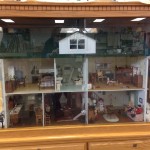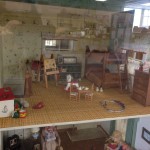Anne Lamott, who wrote the book Small Victories: Spotting Improbable Moments of Grace, has been much in my thoughts lately, along with a talk I’m giving on February 19th at my hometown library in Galesburg, Illinois. Somehow those two thoughts came together because my life is like that: totally disparate items somehow connecting.
Strangely enough, it was one of those “ah ha” moments. It began with a tale of two towns and their libraries.
 I spent my first twenty-one years in Galesburg, Illinois, a blue collar town filled with factories. Once I graduated from Knox College and started my first teaching job, I moved only fifteen miles west to the small town of Monmouth. Both of these towns have public libraries, and Galesburg’s was built by funds from philanthropist and businessman, Andrew Carnegie, but only Monmouth’s original library is still standing. Carnegie’s grants allowed the building of 1,689 libraries in this country. In 1919, this was half of the libraries in America. Thank you, Mr. Carnegie.
I spent my first twenty-one years in Galesburg, Illinois, a blue collar town filled with factories. Once I graduated from Knox College and started my first teaching job, I moved only fifteen miles west to the small town of Monmouth. Both of these towns have public libraries, and Galesburg’s was built by funds from philanthropist and businessman, Andrew Carnegie, but only Monmouth’s original library is still standing. Carnegie’s grants allowed the building of 1,689 libraries in this country. In 1919, this was half of the libraries in America. Thank you, Mr. Carnegie.
My hometown of Galesburg has a great deal of history to recommend it. It is the birthplace of Carl Sandburg and the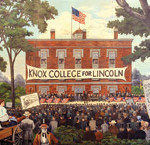 site of the fifth Lincoln-Douglas debate at Knox College. Old Main, the bell tower building on the Knox campus, is one of the few sites still standing from those debates. Knox was a major hub on the Underground Railroad in pre-Civil War days, and it was a hotbed of abolitionist sentiment. After that war, George Washington Gale, an early founder of the town, invented the Ferris wheel, which was first introduced at the Columbian Exposition of the World’s Fair in Chicago in 1893. (Coincidentally, two of my characters in Marry in Haste will attend that fair.)
site of the fifth Lincoln-Douglas debate at Knox College. Old Main, the bell tower building on the Knox campus, is one of the few sites still standing from those debates. Knox was a major hub on the Underground Railroad in pre-Civil War days, and it was a hotbed of abolitionist sentiment. After that war, George Washington Gale, an early founder of the town, invented the Ferris wheel, which was first introduced at the Columbian Exposition of the World’s Fair in Chicago in 1893. (Coincidentally, two of my characters in Marry in Haste will attend that fair.)
But, most importantly, Galesburg is the hub for two major railroads that went east, west, north, and south, and in the little town of Cameron, between Galesburg and Monmouth, one can find the only place in the country where the C, B & Q railroad and the Santa Fe passed over and under each other. That’s quite a railroad history, and one I plan to use in my Endurance mysteries. (After all, I write fiction so I get to move things around.)
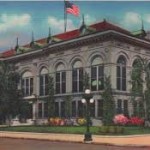 Growing up in Galesburg, a town of 31,000 back in the early 1950s, I soon discovered my family was filled with readers. Both of my parents read voraciously, as did my older brother. As soon as I mastered Dick and Jane stories at Silas Willard School, I was on to longer books. Every week I headed to the Galesburg Public Library with my mother. I loved that library. It was built in 1901 and had a huge, double-wide marble staircase that you faced when you came in the front door. The second floor was a marvel, and part of the floor was made of glass cubes. How intriguing for a little girl of six or seven.
Growing up in Galesburg, a town of 31,000 back in the early 1950s, I soon discovered my family was filled with readers. Both of my parents read voraciously, as did my older brother. As soon as I mastered Dick and Jane stories at Silas Willard School, I was on to longer books. Every week I headed to the Galesburg Public Library with my mother. I loved that library. It was built in 1901 and had a huge, double-wide marble staircase that you faced when you came in the front door. The second floor was a marvel, and part of the floor was made of glass cubes. How intriguing for a little girl of six or seven.
But the very best part of this library was the children’s room which had marvelous wonders, including an intriguing doll house that was filled with miniature furniture and people. This doll house drew me like a magnet. The front was glassed in so I couldn’t actually move things around. But just peering in at the various tiny miniatures each week was a special moment. I always saw details that I hadn’t noticed before. In the back were windows that looked into the rooms from a different angle. I was in heaven. My mother had to pry me away from this eighth wonder of the world every visit.
At that time, my father was managing the Drive-In Theatre several miles west of Galesburg. Our family often spent evenings there in the summer, and as an adult I have such happy memories of those times. One night in 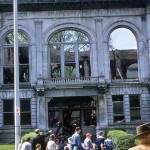 particular, though, was filled with terror and tears: May 9, 1958. We were near the end of the movie, and people began getting out of their cars and looking back to the east. Eleven years old, I had no idea what was going on. But then, in the inky, close darkness, we saw fire lighting up the night sky. My father drove us back into town where we were horrified to see my magnificent library, my cherished and second home, going up in flames. Hundreds of people were standing behind the barricades watching the firemen fighting valiantly to save the building. The crowd was hushed, staring in disbelief. Hardly anyone spoke. Many were in tears, including me. The roof collapsed onto the second floor, and eventually the astonishing second floor—filled with books, chairs and tables, and glass squares—fell into the ground floor.
particular, though, was filled with terror and tears: May 9, 1958. We were near the end of the movie, and people began getting out of their cars and looking back to the east. Eleven years old, I had no idea what was going on. But then, in the inky, close darkness, we saw fire lighting up the night sky. My father drove us back into town where we were horrified to see my magnificent library, my cherished and second home, going up in flames. Hundreds of people were standing behind the barricades watching the firemen fighting valiantly to save the building. The crowd was hushed, staring in disbelief. Hardly anyone spoke. Many were in tears, including me. The roof collapsed onto the second floor, and eventually the astonishing second floor—filled with books, chairs and tables, and glass squares—fell into the ground floor.
Later we found out an exhaust fan in the attic had caught on fire, and the men had trouble fighting the fire because the water pressure was too low in the hydrants. While 40,000 books were salvaged—many water-damaged—the city lost 200,000 books worth half a million dollars. But the most horrible losses of all were four letters signed by Abraham Lincoln and valuable items from the history of the city and the genealogy of families in the area. I will never forget that night and the terrible destruction of so much history and beauty.
Last week I stopped in at the Galesburg Public Library, the small modern structure that sits on the same site as my old, well-loved Carnegie building. I decided to check out the children’s room to see what it looks like these days, and suddenly I saw a dollhouse. It seemed familiar. The librarian told me it was the original dollhouse, one of the few things they had saved from the fire that night fifty-seven years ago. I stared at it, fascinated. There were the tiny rooms just as I remembered them, with the children’s bedroom upstairs and the rocking horse just waiting for the tiny riders. I gazed in wonder, thinking about how my eyes had looked at these same tiny rooms so long ago, long before I grew up and had children and grandchildren of my own. I touched the glass, the same invisible wall that I had touched when I was five or six, and suddenly I was back there in that library with my mom, and we were looking at that perfect reproduction of a well-loved rural home of the 1950s, and pointing out the marvelous miniatures we liked.
It brought back a tumbling jumble of happy memories of those Saturday mornings at my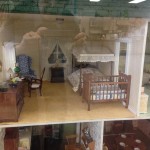 favorite place, when my parents were still alive and my world was smaller and more secure.
favorite place, when my parents were still alive and my world was smaller and more secure.
It was a very special moment of grace.

